- View more resources from this publisher
 STEM Learning
STEM Learning
CPD taster - Designing your science curriculum for success
This is a CPD taster created to give teachers a better understanding of what to expect when joining one of our secondary science leadership courses. Below you will find a video and a task for you to do in your own time. Once you have done the activity, book on Designing your science curriculum for success (NY287).
If you are leading or teaching in a science department, you are probably really invested in creating a curriculum for your students that is logical, robust, accessible and evidence-informed. This course, Designing your science curriculum for success, will allow you to investigate the content of an excellent curriculum and develop your thoughts on what is appropriate for your setting. You will be able to have time to discuss your ideas with others and challenge or reinforce your existing practice.
In the video, Louise Herbert, Professional development leader, explains more. There are then two short tasks that give a sample of the types of activities you will be guided through on this CPD course.
Task 1: What should be in a good scheme?
In the video, Louise discussed the importance of clarity of thinking when starting to develop a scheme of learning. In this task, you will look at some of the possible components of a curriculum, and think about which are your priorities.
Think about the list of possible topics below and rank the items in order of importance to include in a scheme of learning in your setting. As you decide, also consider the reasons for your choice as these may be important in deciding how much time you allocate to each component.
- Diagnostic questions
- Practical skills
- Scientific writing
- Mathematical skills
- Careers
- Real life applications
- Scientific enquiry
- Differentiation
- Prior learning
- Assessment
- Risk assessments
- Homework activities
- Links to other topics/subjects
Task 2: Evaluating your current scheme
Having thought about what you might like to prioritise in your curriculum, this task looks at your existing scheme of learning to think about the things you will use again or build on.
Consider an existing unit of work from your current scheme, and make notes about your opinions for the following prompts. You can do this individually, or discuss with another member of your department.
- What else do you think is important to include in your scheme of learning?
- Who are the most important audiences for your scheme? Does it need to help NQTs and non-specialist teachers and would it still be useful to experienced teachers?
- What 2 or 3 things from the list you have are covered particularly effectively in your department?
- What 2 or 3 things are already in the unit, but could be developed further?
- What is completely missing from your unit, but high in your rank order?
- How readable is your layout? Does it show progression of ideas through the unit clearly? Could you make use of colour coding or overview information?
- Do activities in the scheme meet the objectives of the lesson fully? Highlight any you think do not.
Next steps
In the summary video, Louise explains what you can expect from attending the Designing your science curriculum for success course.
Book your place on Designing your science curriculum for success (NY287).
Show health and safety information
Please be aware that resources have been published on the website in the form that they were originally supplied. This means that procedures reflect general practice and standards applicable at the time resources were produced and cannot be assumed to be acceptable today. Website users are fully responsible for ensuring that any activity, including practical work, which they carry out is in accordance with current regulations related to health and safety and that an appropriate risk assessment has been carried out.




